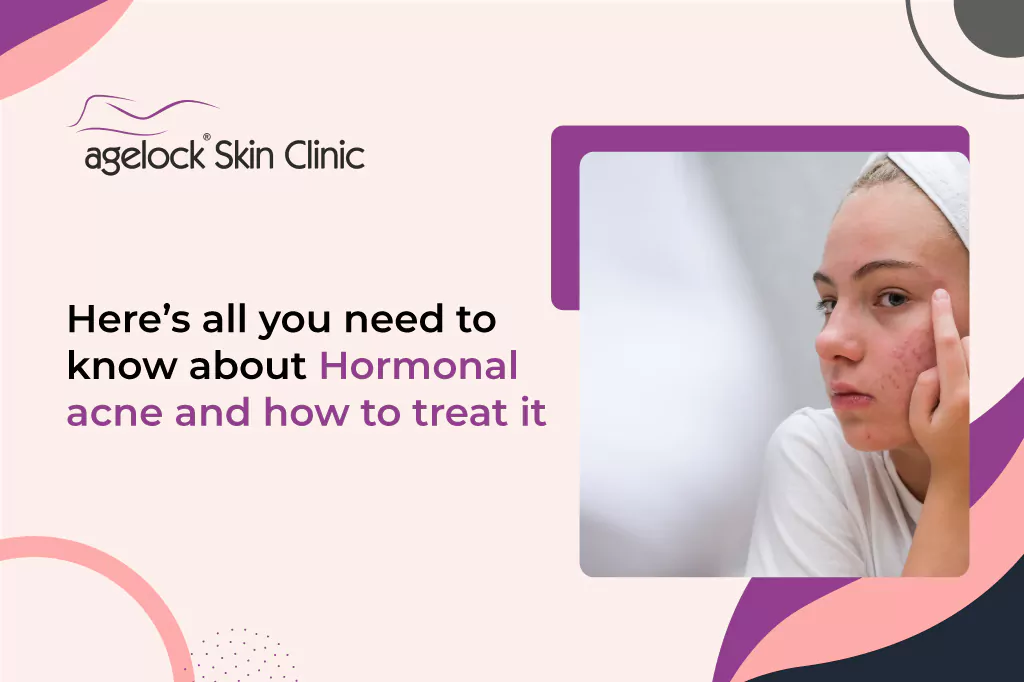Here’s all you need to know about Hormonal acne and how to treat it
Hormonal acne refers to outbreaks caused by hormonal changes, specifically an increase in androgens like testosterone. While acne caused by hormonal changes in puberty is commonly referred to as hormonal acne, it can afflict individuals of any age. It is more prevalent during menstruation and menopause.
This type of acne is more aggravating because you can’t entirely manage the main cause—unbalanced hormones. Acne in adulthood might make you feel anxious as if you don’t present a mature, professional image when you need to.
Symptoms
Hormonal acne commonly arises in the T-zone, which comprises your nose, chin, and forehead, throughout adolescence. Adult hormonal acne may begin in the lower portion of the face, including the jawline and lower cheeks.
Acne can manifest as comedones, which are divided into two types: whiteheads and blackheads.
- Blackheads (open comedones) form on the skin’s surface and become black when sebum reacts with air.
- Whiteheads (closed comedones) are closed pores under the skin’s surface that look white on the surface.
Here are five things people do incorrectly
Keeping an eye out for other acne causes is half the battle. These are five factors that might be exacerbating your breakouts:
- Ignoring lifestyle factors: While you can’t regulate your hormones totally, there are lots of methods to assist them. Your hormones are influenced by how much you sleep, what you eat, and how stressed you are, so keep reading for a few tips on how to balance each aspect of your life.
- Squeezing pimples: Squeezing pimples, especially inflamed hormonal breakouts, is a big no-no. You risk indentation scarring, hyperpigmentation, infection, and even a severe reboot of the same outbreak if you do this.
- Treating each pimple in the same way: The treatment approach for cystic pimples, blackheads, and whiteheads differs significantly from that for inflammatory outbreaks. More on how to treat each type will follow, but keep in mind that what works for your best friend may not work for you, and vice versa.
- Using pore-clogging ingredients: Unfortunately, anyone with acne-prone skin will need to be particularly cautious when it comes to cosmetics. No matter how many preventative treatments you apply, if you employ pore-clogging substances, your breakouts will continue.
- Expecting immediate results: While there are a few outstanding hormonal outbreak therapies available, they will all take at least a few months to show meaningful improvements. It might be irritating to wait, but giving each therapy a few months to kick in before moving on to the next choice can only benefit you in the long run—otherwise, you may miss out on your holy grail.
Causes
Acne can be triggered by hormonal imbalances. Here are a couple of such examples:
- Puberty \sMenstruation
- Menopause
- Polycystic ovarian syndrome (PCOS)
- Elevated androgen levels
A boost in testosterone levels may cause excessive sebum excretion from skin glands. It may also alter the function of some skin cells, resulting in an infection of the hair follicles with the bacteria Cutibacterium acnes. This can result in hormonal acne.
Determine the sort of breakouts you’re dealing with
The key to treating hormonal acne is determining the type of pimples you have. Here’s a simple reference guide to get you started.
Whiteheads have a white tip and may be somewhat elevated on the skin, but they are not very red or inflammatory. This can also appear as skin texture (particularly along the cheekbones) or “congested skin,” as some people refer to it.
Blackheads: As predicted, they appear as blocked pores and are dark brown or black in color. They usually appear around the nose, chin, and middle of the forehead (aka the T-zone). Blackheads are usually flat, however they can sometimes be elevated.
Papule and pustule acne: This form of inflammatory acne is red, elevated, and sensitive. If there is no whitehead, you have a papule. When the red papule develops a white, pus-filled head, you have a painful pustule; both of these require identical treatment, which is why we’re lumping them together for the time being.
The most severe kind of acne is cystic acne. Cysts are huge, inflammatory red pimples that lurk beneath the skin and never form a head. They are normally soft to the touch, but you may sometimes encounter tougher cysts, which are properly known as nodules.
Self-care tips
- Cleanse your face gently twice a day, preferably after intense perspiration.
- Employ gentle cleaners or soaps, as well as lukewarm (not hot) water.
- Exfoliating products and strong scrubs should be avoided.
- Rubbing, picking, or scraping your pimples might irritate.
- When it comes to cosmetics, search for non-comedogenic choices wherever feasible.
- Avoid humid surroundings that cause perspiration.
- Frequent bathing and scrubbing can aggravate acne by removing too much oil from your skin and causing discomfort. As a result, your skin may secrete more oil, exacerbating the acne.
Conclusion
Hormonal acne develops as a result of hormonal variations, particularly testosterone. Increased testosterone levels may encourage excessive sebum production by the sebaceous glands. Clogged pores and acne are caused when sebum interacts with debris, germs, and dead skin cells. Taking really good care of your skin coupled with a consistent skin care routine might give you a head start in preserving your skin even before the acne breakouts start surfacing.





